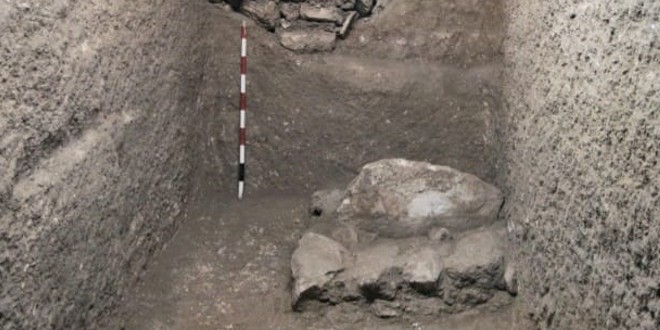Near the Gihon spring in the City of David, a stone slab bearing a curse was discovered. The curse is inscribed on a rectangular stone tablet 26.7 cm wide and 20.8 cm long. The edges of the stone have only been partially preserved. Still, the inscription has been found in its entirety, and its preservation is excellent.
The stone slab was discovered by Eli Shukron, who conducted the excavation near the Gihon Spring area in 2010. In these excavations, a temple and a pillar were also unearthed.
This monumental inscription has been deciphered by Prof. Gershon Galil, Head of the Institute for Biblical Studies and Ancient History, Israel, and the Department of Jewish History and Biblical Studies at the University of Haifa.
The inscription is a curse against the “Governor of the City” of Jerusalem (שר העיר) prepared by his opponents. It consists of 20 words and 63 letters in the ancient Proto-Canaanite script, similar to the Proto-Sinaic script, and may be dated to the end of the Middle Bronze Age II or the Late Bronze Age.
Transliteration and translation of the text: ARWR, ARWR, MT TMT; ARWR, ARWR, MT TMT; SR H’R, MT TMT; ARWR, MT TMT; ARWR, MT TMT; ARWR, MT TMT.
ארור, ארור, מת תמת; ארור, ארור, מת תמת; שר הער, מת תמת; ארור, מת תמת; ארור, מת תמת; ארור, מת תמת
Cursed, Cursed, you will surely die. Cursed, Cursed, you will surely die; Governor of the City, you will surely die; Cursed, you will surely die; Cursed, you will surely die; Cursed, you will surely die.
The stone slab, which dates to the end of the Middle Bronze Age IIB or the Late Bronze Age, is deliberately perforated, with about ten holes arranged in a round outline that resembles the shape of a head.
The holes were drilled inside the limestone but are not visible on the other side of the board. They were performed as a symbolic act, a kind of voodoo ceremony, intended to harm the governor of the city of Jerusalem against whom the inscription was composed.
The inscription indicates a conflict that probably broke out between the “governor of the city,” who was the most senior official of the King of Jerusalem at the time – a kind of “prime minister,” and other priests or officials of the king of Jerusalem, perhaps about economic or personal issues such as levies, temple grants, etc.
Conflicts between the governor and the city residents appear in a few places in the Bible, for example, in the story of Abimelech (Judg. 9). Many conflicts between Assyrian officials are also attested in Neo-Assyrian records.
The title “governor of the City” (שר העיר) appears on a few seal impressions in a similar spelling, on inscriptions 2.4-2.6 from Kuntillet ‘Ajrud and is also mentioned several times in the Bible (2 Kings 22: 26; 23: 8; 2 Chronicles 34: 8).
The use of mater lectionis in the Jerusalem stone inscription and other ancient inscriptions was not uniform, as evidenced by the Ugaritic texts. In the Jerusalem stone inscription, only ’arur is written in plane spelling, not the other words.
Curses and cursing ceremonies are well known from the Egyptian execration texts written on pottery sherds or figurines from the Bronze Age (esp. the 20th-19th centuries BCE), which also mention the King of Jerusalem; as well as from magical ceremonies held against the Lamashtu in Mesopotamia. The Egyptian execration texts include references to enemy cities and kings in Canaan. These personal names and toponyms were written on pottery sherds or figurines, which were deliberately smashed to cause damage to the enemies of Egypt and to bring about the annihilation of the cursed Canaanite rulers.
Prof. Galil noted that: “The new inscription proves that Jerusalem was not only a fortified city but also a vital cultural and cultic center, where excellent scribes and sophisticated magicians managed to write this important monumental inscription, as well as hold voodoo ceremonies.” Prof. Galil also pointed out that, “being the earliest known inscription of this sort in Canaan, it must have served as a model for other writers and priests in later periods and in different places in the land.”
According to Eli Shukron, who led the excavation: “This is an important find as it helps to date the finds near the Gihon Spring to the Middle Bronze Age IIb.” He also added that: “Additional data unearthed in this area indicate that the mighty fortifications near Gihon existed continuously until the Eighth century BCE, and testify to the strength and resilience of Canaanite and Israelite Jerusalem, in the Middle/Late Bronze age, as well as in the 10th century, after King David turned the city into the capital of the Israeli Great Empire. In the days of David and Solomon, it was a fortified city and included walls (near the Gihon) whose height was preserved to a height of eight meters and a width of 3.5 meters.”
The shortcode is missing a valid Donation Form ID attribute.


